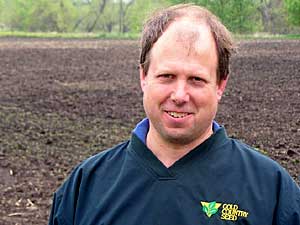|
Audio
Photos
|
May 31, 2005
 |
| Glencoe area farmer Greg Stuedemann is one of Minnesota's soy rust first detectors. He's been trained to spot the first signs of the disease. (MPR Photo/Tim Post) |
Glencoe, Minn. — Geir Friisoe is the guy to turn to for the facts on soybean rust. Friisoe is a plant disease expert at the Minnesota Department of Agriculture. In fact, the U.S. Department of Agriculture called him for help when soybean rust was found in Louisiana last fall. He and other agriculture experts think spores spreading the disease, travelled from South America on the winds of a hurricane.
"Soybean rust is a fungus. It attacks the part of the plant that takes energy from the sun and converts it into sugars and proteins that are needed to produce the crop," Friisoe said.
That's a concern for farmers in Minnesota, a state that supplies 10 percent of the nation's soybeans. Friisoe says the state Department of Agriculture is taking soy rust seriously.
"It's been documented to show yield losses as high as 70 percent if left untreated. The threat is very real, very large, and we have taken a number of steps to try to get prepared," he said.
Some of that preparation is happening in a small farm field just east of Glencoe in Mc Leod County. Farmer Greg Stuedemann is surveying the muddy seven-acre plot. In recent days tiny soybean seedlings have started to emerge from the soil. Stuedemann says if soy rust makes it to Minnesota, he can guarantee this field will be infected. It's a sheltered spot that holds moisture well, a breeding ground for plant diseases.
"We've got a grove on the north, buildings to the west, Buffalo Creek borders the south side of the field. If there ever was a field with perfect conditions for the rust spores to settle, it's probably a field such as this," Stuedemann said.
That's OK, because these soybeans are here to catch soy rust, it's a sentinel plot. This crop was planted early, so if rust spores are present it will get the disease early, giving nearby farmers a chance to spray their crops to stop an outbreak. They don't want to spray for the disease unless necessary, since it costs $15 to $20 per acre to do so.
Stuedemann, who farms a thousand acres of mixed crops just up the road, has been trained to spot the first signs of soy rust. He's one of the state's soybean rust first detectors. In fact there are thousands of farmers like him across much of the country, who'll spend the spring and summer scanning plants with a magnifying glass.
Local University of Minnesota Extension educator Dave Nicolai is helping teach these crop detectives to recognize the tell-tale signs of soy rust.
"Think about rust on a piece of metal turning red. You're going to see reddish to brownish type of lesions. And then as it progresses it spreads across the leaf, you get holes in the leaves followed by defoliation," Nicolai said.
So far this spring, soy rust has popped up in Georgia and Florida. It could hitch a ride up to Minnesota on weather systems from the Gulf of Mexico. But Minnesota farmers will know well ahead of time if soy rust is closing in. There are several government websites set up to track its movement.
Farmers like Greg Stuedemann are taking this latest business challenge in stride.
"If it's not a disease, it's an insect. That's the way it's been since people starting cultivating plants. It's a constant adaptation. It's just an ongoing rhythm and cycle of pests. You cure one thing there's always something else waiting in the wings to take it's place," he said.
Minnesota farmers have an advantage when it comes to soy rust. The disease can't survive freezing temperatures. So even if it comes to Minnesota in the summer, it would be eradicated in the winter, and have to make it's way back north next growing season.
Fears about soy rust are changing what some farmers are planting. In the south, the USDA reports farmers have put in fewer acres of soybeans. Some agriculture experts say that could mean stronger markets and better prices for farmers in northern states like Minnesota, where soy rust isn't expected to be as much of a problem.






